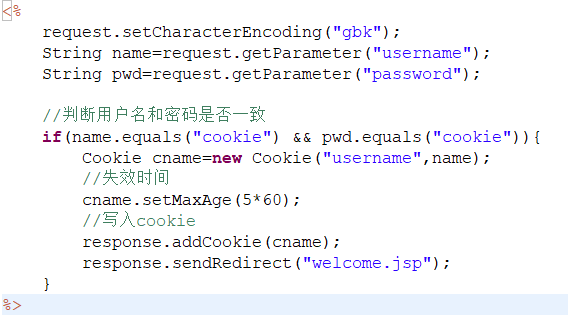application内置对象
application实现用户之间的数据共享
void setAttribute(String key,Object value) 以key/value的形式保存对象值
Object getAttribute(String key) 通过key获取对象值
String getRealPath(String path) 返回相对路径的真实路径
统计网站访问次数:
<%
//获取当前网站的访问次数
Integer count=(Integer)application.getAttribute("count");
if(count!=null){
count++;
}else{
count=1;
}
application.setAttribute("count", count);
%>
<%
out.print("当前网站访问次数:"+application.getAttribute("count"));
%>
作用域
从小到大:page(pageContext)--->request---->session---->application
page对象作用域只在当前页面有效
request作用域是在当前请求内有效
session作用域是在当前会话内有效
application对象的作用域是在应用上下文
cookie对象的常用方法:
void setMaxAge(int expiry):设置cookie的有效期,以秒为单位;
void setValue(String value):在cookie创建后,为cookie赋予新的值;
String getName():获取cookie的名称;
String getValue():获取cookie的值;
int getMaxAge():获取cookie的有效时间,以秒为单位;
使用cookie:
创建cookie对象:
Cookie newCookie=new Cookie(String name,String value);
写入cookie:
response.addCookie(newCookie);
读取cookie:
<%
response.addcookie(new Cookie("username","jack"));
response.addcookie(new Cookie("password","123456"));
response.sendRedirect("info.jsp");
%>
cookie有效期:

cookie与session作用域的对象:
session作用域是在服务器端保存用户信息,cookie是在客户端保存用户信息;
session作用域中保存的值是object类型,cookie保存的值是String类型;
session作用域随会话的结束而将其存储的数据销毁,cookie可以长期保存在客户端;
cookie通常用于保存不重要的用户信息,重要的信息使用session作用域保存;